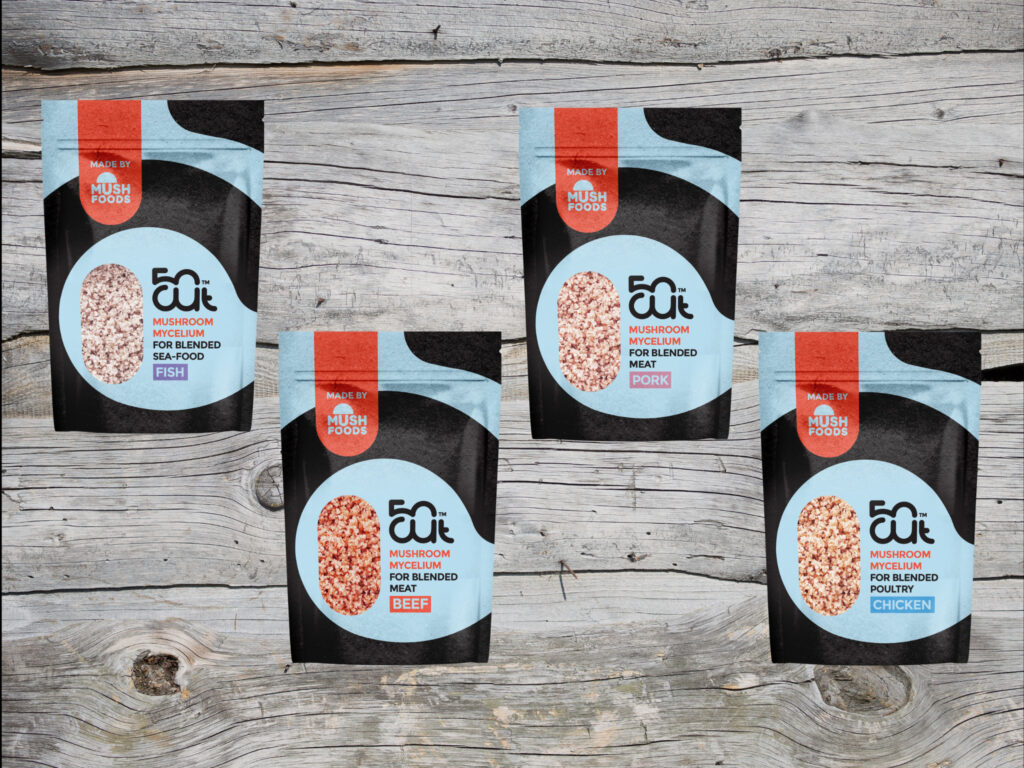Blended & Hybrid Meat: What Do Sustainable Protein Policy Advocates Think?
8 Mins Read
As blended and hybrid meats begin to sizzle, Green Queen speaks to alternative protein bodies the Good Food Institute and ProVeg International to get their take on this novel approach to protein diversification.
This article is part of our content series exploring the world of hybrid and blended meat products – those blending cultivated or conventional proteins with plant-based ingredients, respectively, and why some think this is the future of reducing meat consumption.
Over the last few weeks, we’ve interviewed founders of various blended and hybrid meat startups, as we explore the potential of this approach. Plant-based meats have hit a roadblock in the last year, and cultivated meat is still in its commercial infancy, but – as the myriad reports published on the eve of COP28 next week say – we need to decarbonise fast, and now.
We’re on track to approach temperatures 3°C higher than pre-industrial levels, which present beyond-catastrophic implications. The global food system is responsible for a third of our greenhouse gas emissions, and meat production itself contributes to 60% of this share. Research suggests that replacing 50% of our meat and dairy intake with plant-based alternatives – which is essentially what blended meat is doing – can halt deforestation and double climate benefits.
The founders we’ve spoken to underline the potential for blended and hybrid meats as a means of protein diversification, and they are – as you’d expect – highly optimistic. But what do think tanks and sustainable food advocacy platforms think?
To find out, we spoke to the alternative protein think tank the Good Food Institute (GFI), the Good Food Institute APAC, and food systems change non-profit ProVeg International, to share their views on blended and hybrid meat. Here’s what they had to say:
On blended meat acceptance
GFI says any approach that can get alternative proteins closer to taste and price parity with conventional meat is worth leveraging, and blended meat can support both aspects. Combining pricier plant proteins with conventional meat can achieve comparable markups – but GFI highlights its focus by adding that this could eventually help increase scale to a point where plant-based proteins become cheaper than conventional meat.
GFI APAC’s managing director Mirte Gosker, meanwhile, added that these gateway products “present an opportunity for legacy food companies to dip their toe in, test the market, and provide a stepping stone towards increased plant-based food consumption” and open up “a lucrative new revenue stream for plant-based ingredient suppliers”.
But ProVeg has a slightly sterner stance on blended meat. Its cellular agriculture lead Julia Martin said that while the organisation “actively promotes” hybrid meat, it merely “tolerates” blended meat, acknowledging that the latter could be a “possible solution for the time being”.

On hybrid meat acceptance
“These combinations have a bigger potential to become sustainable long-term solutions,” Martin says of hybrid meats, adding that they “have a great potential to accelerate and expand consumer transition away from animal-based foods and towards a kinder and more sustainable food system”.
“Moreover, as cultivated meat technology develops, hybrid products are an impactful first step in creating familiarity among consumers with ingredients produced through this novel technology,” she adds.
GFI says the argument for hybrid products is similar to that of blended meat, but notes the dynamics are flipped on cost. Most cultivated meat offerings that will come to market in the short-term are likely to be hybrid, in order to provide a more accessible price point- currently, these are very expensive to produce. Cultivated meat can offer similar sensory improvements that conventional meat does in blends.
Additionally, the think tank believes that using cultivated fat as an ingredient in primarily plant protein products (as companies like Mission Barns are doing) could be especially attractive, as fat is essential for flavour and a meaty mouthfeel.
On investor support
“In the current economic environment, fundraising is not only challenging for companies in the hybrid space, but across all of the food tech industry,” notes Martin. “Fortunately, we are starting to see the first cultivated companies apply for regulatory clearance and even hit the market, and hopefully, this will serve as proof of the immense impact that these products are able to deliver and stimulate further confidence into the space.”
“The blended meat category is still very nascent, so there isn’t much investor data available. So far, it is mostly large-scale food companies that have ventured into offering such products,” says Gosker, pointing to the examples of Perdue Farms, Tyson and Hormel.
Perdue Farms, which used Better Meat Co.‘s mycelium-derived Rhiza protein in its blended meat range, told GFI in its State of the Industry Report 2022 that it has been “extremely successful since launching in 2019”, with new flavours and formats being added to the category.
Smaller-scale companies have also attracted investor interest: Los Angeles-based blended meat maker Paul’s Table has raised $500,000 in pre-seed funding, while San Francisco’s hybrid meat startup SciFi Foods emerged from stealth last year with a $22M Series A round. Andrew Arentowicz, CEO of blended meat company 50/50 Foods Inc (also from LA) – which mixes meat with vegetables – told Green Queen its “investors are very bullish on our potential”. A similar startup, New York-based Phil’s Finest, found success on Shark Tank too.
Meanwhile, Shalom Daniel, founder of Israeli blended meat producer Mush Foods, told Green Queen: “We’ve found investors – including those who are strongly anti-meat – are committed to the welfare of the planet and animals and see the blended solution as an immediate and achievable means of reducing meat consumption.

On consumer interest
“As cultivated meat technology develops, hybrid products are an impactful first step in creating familiarity among consumers with ingredients produced through this novel technology,” says Martin.
To gauge consumer opinion about hybrid meats, ProVeg conducted a UK-wide survey last year, asking 1,000 Brits whether they’d eat these products. A third of respondents said they would, a result ProVeg calls “quite promising, especially given that the vast majority of people are not at all familiar with this novel product category”, though a similar number of people (30%) were unsure about consuming these products, highlighting the need for increased public awareness and familiarity.
The acceptance for these products was higher among younger generations and men, with about 40% of millennials and Gen Zers expressing interest, versus 32% of Gen Xers and 29% of boomers. Men (39%) are more likely to try these products too (compared to 31% of women). University-educated millennials and Gen Z men are, in general, more open to eating (51%) and buying (47%) hybrid meat.
GFI says it is planning to conduct its first report on blended meat in the near future. Moreover, an investor who attended GFI’s Good Food Conference 2023 in September told Green Queen the panel on blended meat had a high level of engagement and was much more well attended than in previous years.
On marketing
How these products are presented to customers is vital to their success. GFI alludes to this in its State of the Industry report. “Communicating the benefits of blended products to consumers may require nuanced product positioning, as this is a relatively new and subtle category that requires a clear value proposition,” it states. “Targeting the right consumer groups will be critical – for example, parents who want to incorporate more vegetables into their children’s meals.”
With hybrid meats, Martin says the “trend is definitely focusing on the superior sensory attributes” provided by hybrid products – especially those composed of plant-based proteins with cultivated fats ( as GFI mentioned above). “These products are likely to be initially marketed as premium, but that’s just natural in early adoption cycles for any novel category.”
GFI APAC’s Gosker adds: “Non-meat ingredients such as meat extenders, starches and binders have long played a role in developing conventional meat products to reduce costs for consumers or add functionality, but the new wave of plant-based innovation offers plenty of room for more strategic integration of higher-quality ingredients that bring added nutritional benefits.
“If brands select plant-based ingredients that offer advantages such as lower fat and desirable vitamins and nutrients, this could increase the overall health profile of a conventional meat product in a way that is broadly appealing to consumers.”
Gosker stresses the need for further research to determine where these products need to be shelved in-store, how best to communicate to customers that they contain both animal and plant-based ingredients, how to establish a value proposition for these meats, and which blends perform best in different formats and contexts.
Paul Shapiro, co-founder and CEO of Better Meat Co (which supplies to Perdue), told Green Queen that blended meat must be marketed as “enhanced meat – something better than a product that’s solely animal meat”. “This is what Perdue does, and its Chicken Plus product has performed well on the market for nearly four years now,” he outlined.

On the category’s challenges
Where next for blends and hybrids? “Consumers across different geographies are excited to try the products,” says Martin, though she warns that early products will have high prices and very limited availability. “However, as the technology evolves, it is expected that costs will decrease making products more accessible, as well as increase their availability.”
GFI reiterates the hurdles relating to category, product and brand positioning, as well as consumer communication, adding that blended and hybrid meats will need to reach a broader audience of meat-eating consumers to truly fulfil their potential.
Gosker concurs with Martin’s point about public excitement. “Consumer interest and potential demand for blended meat products are evident – but to grow as a category, [companies] will need to hit the trifecta of achieving price parity, meeting or exceeding consumer expectations on taste and texture, and effectively communicating their benefits over conventional meat,” she explains.
“Fortunately, blends are positioned to compete well on price, since they offer wide flexibility in ingredient ratios to adjust for taste, texture and cost optimisation. Indeed, some conventional meat producers have even managed to lower their total product costs by integrating plant-based proteins, thereby making their blended products more affordable from a cost-of-goods standpoint than conventional meats.”
She echoes GFI’s statement about how growing demand for blended meat could ramp up plant protein production, reaching a scale that will close the price gap between animal and plant proteins. GFI, though, envisions a multi-hybrid future. The organisation that named plant-based, cultivated and fermented proteins as the three pillars of the alt-protein category says the lines between these products will blur.
Each offers unique advantages, and the products most likely to win on taste and price would ideally leverage the best of all of these platforms. For example, a meat alternative composed primarily of plant proteins, a dash of cultivated fat and key flavour-boosting ingredients like fermentation-derived heme proteins, perhaps? Could be a winning formula for early actors in this space!



